Characteristics
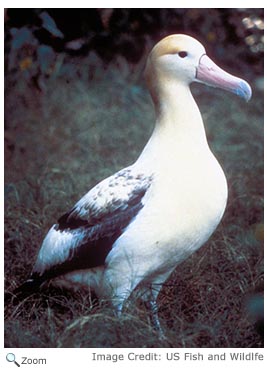 The short-tailed albatross is a large seabird, 33-36 inches in lenght, with a 7 foot wingspan. It has light yellowish-brown feathers on its head and the back of its neck and a white chest and belly. It has black and white wings, yellow feet, and a large pink bill with a blue tip. Juvinile short-tail albatrosses are brown. Despite its name, the tail of the short-tailed albatross is not shorter than the tails of other albatross species. The short-tailed albatross is a large seabird, 33-36 inches in lenght, with a 7 foot wingspan. It has light yellowish-brown feathers on its head and the back of its neck and a white chest and belly. It has black and white wings, yellow feet, and a large pink bill with a blue tip. Juvinile short-tail albatrosses are brown. Despite its name, the tail of the short-tailed albatross is not shorter than the tails of other albatross species.
Range
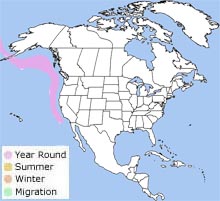 The short-tailed albatross was once found in large numbers in the North Pacific Ocean around the seas of Taiwan and Japan. Today, the short-tailed albatross breeds on two islands in the Pacific Ocean. It occasionally is sighted off the Pacific Coast of the united States, south to California. The short-tailed albatross was once found in large numbers in the North Pacific Ocean around the seas of Taiwan and Japan. Today, the short-tailed albatross breeds on two islands in the Pacific Ocean. It occasionally is sighted off the Pacific Coast of the united States, south to California.
Habitat
The short-tailed albatross lives on the open ocean waters and islands.
|
|
Diet
The short-tailed albatross eats flying
fish eggs, crustaceans, shrimp, and squid. It usually feeds in the early
morning and at twilight.
Life Cycle
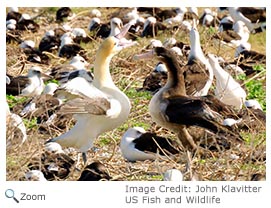 Short-tailed albatrosses begin breeding when they are 6-7 years old. Pair mate for life and return to the same nesting site year-after-year. Short-tailed albatrosses begin breeding when they are 6-7 years old. Pair mate for life and return to the same nesting site year-after-year.
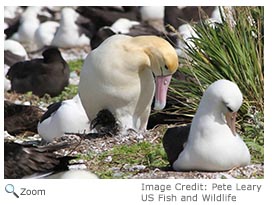 The female lays a single egg. The chick hatches in a little over two months and stays in the nest for up to five months. The female lays a single egg. The chick hatches in a little over two months and stays in the nest for up to five months.
Behavior
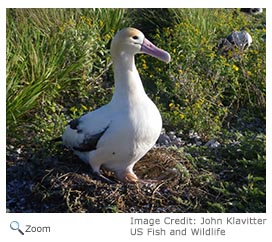 At the turn of the 20th century, close to five million short-tailed albatrosses were killed for their feathers. In fact, the short-tailed albatross was thought to be extinct until 1951 when a colony was discovered in
Torishima Islands south of Japan.
A second nesting colony was discovered on
Minami-kojima
Island
south of Taiwan in 1979. Conservation efforts have increased the world-wide population of the short-tailed albatross to close to 1,000 birds. At the turn of the 20th century, close to five million short-tailed albatrosses were killed for their feathers. In fact, the short-tailed albatross was thought to be extinct until 1951 when a colony was discovered in
Torishima Islands south of Japan.
A second nesting colony was discovered on
Minami-kojima
Island
south of Taiwan in 1979. Conservation efforts have increased the world-wide population of the short-tailed albatross to close to 1,000 birds.
|